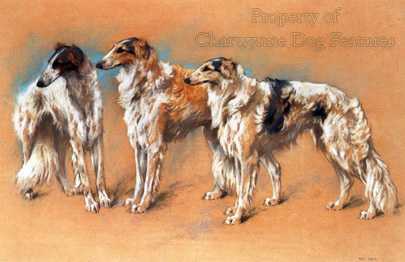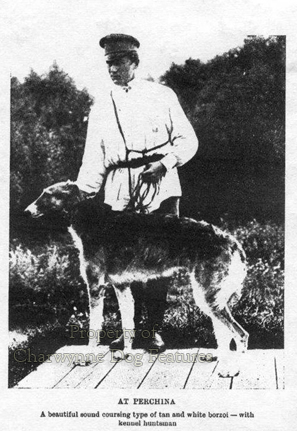798 RUSSIAN SIGHTHOUNDS
Regarding Russian Running Dogs
by David Hancock
 The new meritocracy in Russia seems to be reviving the hunting Borzoi, as national pride in their sporting past re-asserts itself. The show Borzoi in Western Europe is now confined by a closed gene pool, in the rigid pursuit of purity rather than performance, and unused by sportsmen, but the lesser known Borzoi types are really South Russian lurchers both in employment and in breeding method. We know little of the Chortaj or West Russian Coursing Hound or Eastern Greyhound and the Steppe Borzoi or South Russian Steppe Hound, both smooth-coated 26" sighthounds. Behind the modern single breed of Russian Borzoi, there are barrel-chested Caucasian Borzoi, huge curly-haired Courtland Borzoi and bigger-boned Crimean dogs. This type was found as far west as Albania too, being favoured by nomadic tribes.
The new meritocracy in Russia seems to be reviving the hunting Borzoi, as national pride in their sporting past re-asserts itself. The show Borzoi in Western Europe is now confined by a closed gene pool, in the rigid pursuit of purity rather than performance, and unused by sportsmen, but the lesser known Borzoi types are really South Russian lurchers both in employment and in breeding method. We know little of the Chortaj or West Russian Coursing Hound or Eastern Greyhound and the Steppe Borzoi or South Russian Steppe Hound, both smooth-coated 26" sighthounds. Behind the modern single breed of Russian Borzoi, there are barrel-chested Caucasian Borzoi, huge curly-haired Courtland Borzoi and bigger-boned Crimean dogs. This type was found as far west as Albania too, being favoured by nomadic tribes. 
The physical beauty of the Russian wolfhound has long drawn widespread admiration here. Undoubtedly the attractive silky coat of the modern pedigree Borzoi enhances its visual appeal. But as with the Saluki and the Ibizan hound, of this type of swift hound, there were varieties of coat in the Borzoi too. The Hunter's Calendar and Reference Book, published in Moscow in 1892, divided the Borzoi into four groups. First, Russian or Psovoy Borzoi, more or less long-coated; second, Asiatic, with pendant ears; third, Hortoy, smooth-coated and fourth, the Brudastoy, stiff-coated or wire-haired. But whether the hounds were sleek or bristle-haired, wolf coursing in Russia before the Revolution was what fox-hunting was to Britain and par force hunting was to France.
Hunting from sledges sometimes took place from October, with mounted beaters putting up the wolves, which were often fed to keep them in the hunting grounds. In the Perchino game reserve, between 1887 and 1913, 681 wolves were killed, as well as 743 foxes, 4,630 brown hares and 4,026 white hares; Borzois obtaining the bulk of this bag. Whatever the rights and wrongs of hunting on such a scale, the robustness, fitness and stamina of the hounds must have been remarkable. Coursing with Borzois in Tsarist Russia called for a high standard of horsemanship and superbly-trained hounds. Each mounted handler rode with his three hounds on long leashes, slipping the hounds whenever a wolf was either put up by the extended line of mounted beaters or flushed out of the woods by scent hounds of the Gontchaja type. Many of us would find it difficult enough to control three Borzois on short leashes whilst dismounted!
The Borzoi is still important for the Russian fur trade, for they catch foxes without mauling them and ruining their pelts. This also avoids the crueller use of iron spring traps. Usually 20 leashes of Borzois were taken to a hunt, each consisting of two males and a bitch. The hunting season was summer coursing (June to early August) on hare or fox, then summer training for Borzois in August. This consisted of 20 kilometres walking or trotting with the hunt horses, followed by advanced training on captive wolves in early September, then the wolf-coursing season from mid-September to the end of October. All too often we only associate the hunting Borzoi with snowy forests and the wolf habitat but the finest hunting ground for the Russian sighthounds will forever be the steppes. 
The real all-round 'hunting by speed' field dogs from Russia are the mid-Asiatic Tasy or East Russian Coursing Hound and the Taigan or Kirghiz Borzoi. The Circassian Greyhound, also known as the Crimean, Caucasian or Tartary Greyhound, is more Saluki-like, understandably so, as the Circassians could be found as far afield as Syria and Iraq. The Tasy and the Taigon, both over two feet at the withers, are fast, robust, determined, all-purpose hunting dogs and like the similar breeds of Chortaj (pronounced Hortai) and the Steppe Borzoi, remain unrecognised by most international registries. This means that their breeding remains in the hands of the hunters not the exhibitors. The Tasy hails from the desert plains east of the Caspian Sea, featuring a ringed tail and heavy ear feathering, with a likely common origin with the better known Afghan Hound, sometimes called the Tazi in its native country. Used on hare, fox, marmot, hoofed quarry and even wolf, the Tasy is remarkably agile, with a good nose as well as great speed and legendary stamina, often being used with the hawk, providing fur pelts as well as meat. One famous Tasy was valued at 47 horses, such was its prowess in the hunt.
The Taigon operated further east, in the high altitude Tien Shan region on the border with China. Used, sometimes with falcons, to hunt fox, marmot, badger, hare, wildcat, wolf and hoofed game, these sighthounds could follow scent too but were renowned for their extraordinary stamina at high altitude. They may disappear as more urban living entices their fanciers, but their blood could be so valuable to the inbred pedigree sighthounds of the west. It would be good to learn of a sportsman here using such blood as an outcross for lurchers; it would a great pity if such a source is lost.